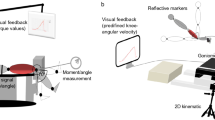Summary
The aim of this study was to assess the effects in humans of early (2 weeks) and delayed (6 weeks) isokinetic strength training in the recovery of muscle strength following an arthroscopic partial meniscectomy. The peak torque developed in the quadriceps and hamstrings and the torque developed at a knee angle of 1.05 rad were evaluated in 16 subjects, pre-operatively (pre-op), and 2, 6, and 10 weeks post-operatively (post-op), on an isokinetic device at four different velocities (1.05, 2.09, 3.14, and 4.19 rad · s−1). The fatigue characteristics of the muscles were evaluated by having the subject perform 15 maximal contractions at 3.14 rad · s−1. Training was done on the same device (three times a week for 1–2 months), beginning either 2 or 6 weeks post-op. A repeated measures analysis of variance demonstrated a time effect but no differences between groups and no interactions. Torques developed by the knee flexors and extensors were significantly smaller 2 weeks post-op than pre-op, at all velocities tested. Torques developed in the quadriceps recovered to their pre-op values by 6 weeks, and further gained significantly in strength from 6 to 10 weeks. Quadriceps torques remained weaker than the contralateral side at 10 weeks. Hamstrings torques were either higher or similar to pre-op values by 6 weeks, and demonstrated increases from 6 to 10 weeks post-op at 1.05 and 4.19 rad · s−1 only. Total work and average power developed by the quadriceps and hamstrings during the fatigue protocol changed with time in a similar manner to torque. However, contrary to quadriceps torque, these indices of fatigue were fully recovery by week 10. In conclusion, training in the early stages following arthroscopic meniscectomy does not appear to improve the recovery of strength and the importance of timing of the training stimulus is suggested. Moreover, the results emphasize the need to include a control group when investigating the role of exercise training in the recovery of muscle function.
Similar content being viewed by others
References
Burdett RG, Van Swearingen J (1987) Reliability of isokinetic muscle endurance tests. J Orthop Sports Ther 8:484–488
Elmqvist L-G, Lorentzon R, Johansson C, Langstrom M, Fagerlund M, Fugl-Meyer AR (1989) Knee extensor muscle function before and after reconstruction of anterior cruciate ligament tear. Scand J Rehabil Med 21:131–139
Fitts RH, Brimmer CJ (1985) Recovery in skeletal muscle contractile function after prolonged hindlimb immobilization. J Appl Physiol 59:916–923
Gardiner PF, Lapointe M, Gravel D (1982) Exercise effects on recovery of muscle acetylcholinesterase from reduced neuromuscular activity. Muscle Nerve 5:363–368
Grimby G, Gustafsson E, Peterson L, Renstrom P (1980) Quadriceps function and training after knee ligament surgery. Med Sci Sports Exerc 12:70–78
Halkjaer-Kristensen J, Ingemann-Hansen T, Saltin B (1980) Cross-sectional and fibre area changes in the quadriceps muscle of man with immobilization and physical training. Muscle Nerve 3:275–276
Hamberg P, Gillquist J, Lysholm J, Oberg B (1983) The effect of diagnostic and operative arthroscopy and open meniscectomy on muscle strength in the thigh. Am J Sports Med 11:289–292
Herbison FJ, Jaweed MM, Ditunno JF, Scott CM (1973) Effect of overwork during reinnervation of rat muscle. Exp Neurol 41:1–14
Ingemann-Hansen T, Halkjaer-Kristensen J (1980) Computerized tomographic determination of human thigh components: the effects of immobilization in plaster and subsequent physical activity. Scand J Rehabil Med 12:27–31
Ingemann-Hansen T, Halkjaer-Kristensen J (1983) Progressive resistance exercise training of the hypotrophic quadriceps muscle in man. Scand J Rehabil Med 15:29–35
Ingemann-Hansen T, Halkjaer-Kristensen J (1985) Physical training of the hypotrophic quadriceps muscle in man. Scand J Rehabil Med 13:38–55
Kasper CE, White TP, Maxell LC (1990) Running during recovery from hindlimb suspension induces transient muscle injury. J Appl Physiol 68:533–539
Knight KI (1985) Quadriceps strengthening with the Dapre technique: case studies with neurological implications. Med Sci Sports Exerc 17:646–650
Krebs DE (1989) Isokinetic, electrophysiologic, and clinical function relationships following tourniquet-aided knee arthrotomy. Phys Ther 69:803–815
Laforest S, St-Pierre DMM, Cyr J, Gayton D (1990) Effects of age and regular exercise on muscle strength and endurance. Eur J Appl Physiol 90:104–111
Montgomery LC, Douglass LW, Deuster PA (1989) Reliability of an isokinetic test of muscle strength and endurance. J Orthop Sports Ther 10:315–322
Patel D, Fahmy N, Sakayan A (1982) Isokinetic and functional evaluation of the knee following arthroscopic surgery. Clin Orthop Relat Res 167:84–91
St-Pierre DMM, Leonard L, Gardiner PF (1987) Recovery of muscle from tetrodotoxin-induced disuse and the influence of daily exercise. 1. Contractile properties. Exp Neurol 98:472–488
St-Pierre DMM, Leonard L, Houle R, Gardiner PF (1988) Recovery of muscle from tetrodotoxin-induced disuse and the influence of daily exercise. 2. Muscle enzymes and fatigue characteristics. Exp Neurol 98:472–488
Thorblad J, Ekstrand J, Hamberg P, Gillquist J (1985) Muscle rehabilitation after arthroscopic meniscectomy with or without tourniquet control. Am J Sports Med 13:133–135
Vegso JJ, Genuario SE, Torg JS (1985) Maintenance of hamstring strength following knee surgery. Med Sci Sports Exerc 17:376–379
White TP, Villanacci JF, Morales PG, Segal SS, Essig DA (1984) Exercise-induced adaptations of rat soleus muscle grafts. J Appl Physiol 56:1325–1334
Witzmann FA, Kim DH, Fitts RH (1982) Recovery time course of contractile function of fast and slow skeletal muscle after hindlimb immobilization. J Appl Physiol: Respir Environ Exerc Physiol 52:677–682
Author information
Authors and Affiliations
Rights and permissions
About this article
Cite this article
St-Pierre, D.M.M., Laforest, S., Paradis, S. et al. Isokinetic rehabilitation after arthroscopic meniscectomy. Europ. J. Appl. Physiol. 64, 437–443 (1992). https://doi.org/10.1007/BF00625064
Accepted:
Issue Date:
DOI: https://doi.org/10.1007/BF00625064




